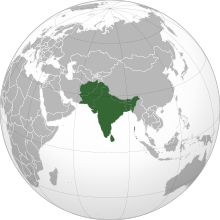Südasien
Südasien ist ein Teil des asiatischen Kontinents und wird im Nordwesten, Norden und Nordosten durch Gebirge vom übrigen Asien abgetrennt. Der Raum wird bis heute, obwohl der Begriff teilweise als veraltet und kolonial-historisch besetzt gilt, auch als Vorderindien bezeichnet, es bestehen weitreichende Überlappungen zwischen den Begriffen Mittlerer Osten, indischer Subkontinent und Südasien.


In Südasien leben 25 Prozent der Weltbevölkerung, allein in Indien leben über 1,4 Milliarden Menschen (2023).
Abgrenzung
BearbeitenGeologisch wird ein großer Teil Südasiens, da es eine eigene tektonische Platte darstellt, auch als indischer Subkontinent bezeichnet. Umgrenzt wird der Raum:
- vom Himalaya im Norden gegen Tibet (Ostasien) und dem Pamir gegen Zentralasien,
- dem Bergland von Belutschistan im Westen gegen Vorderasien,
- vom Patkai und Arakan-Joma-Gebirge im Osten gegen Südostasien.
- Nach Süden ist er vom Indischen Ozean umschlossen, mit dem Arabischen Meer westlich und dem Golf von Bengalen östlich der Halbinsel Indien.
Liste der Staaten
BearbeitenAlle Staaten in Südasien, unter anderem basierend auf der SAARC, sind:[1][2][3][4][5][6][7]
- Afghanistan (hauptsächlich jedoch zu Zentralasien gezählt[8])
- Bangladesch
- Bhutan
- Indien
- Malediven
- Nepal
- Pakistan
- Sri Lanka
Iran wird durch die UNSD, eine Abteilung der Vereinten Nationen, zu statistischen Zwecken ebenfalls zu Südasien gezählt,[9] in der Regel zählt Iran jedoch weltweit zu Westasien.
Literatur
Bearbeiten- Feroz Hassan Khan: Subcontinent Adrift: Strategic Futures of South Asia. Cambria, Amherst 2022, ISBN 978-1-62196-648-7.
- David Arnold: Südasien (= Neue Fischer Weltgeschichte. Band 11). S. Fischer, Frankfurt am Main 2012, ISBN 978-3-10-010841-8.
Weblinks
BearbeitenEinzelnachweise
Bearbeiten- ↑ Arthur Berriedale Keith: A Constitutional History of India: 1600–1935. Methuen & Co, 1936, S. 440–444.
- ↑ N. D. Arora: Political Science for Civil Services Main Examination. Tata McGraw-Hill Education, 2010, ISBN 978-0-07-009094-1, S. 42:1.
- ↑ Indian subcontinent. In: New Oxford Dictionary of English. Oxford University Press, New York 2001, ISBN 0-19-860441-6, S. 929: "the part of Asia south of the Himalayas which forms a peninsula extending into the Indian Ocean, between the Arabian Sea and the Bay of Bengal
- ↑ John McLeod: The history of India. Greenwood Publishing Group, 2002, ISBN 0-313-31459-4, S. 1.
- ↑ Stephen Adolphe Wurm, Peter Mühlhäusler, Darrell T. Tryon: Atlas of languages of intercultural communication in the Pacific, Asia, and the Americas. International Council for Philosophy and Humanistic Studies. Walter de Gruyter, 1996, ISBN 3-11-013417-9, S. 787.
- ↑ The Columbia Electronic Encyclopedia. 6. Auflage. Columbia University Press, 2003: "region, S central Asia, comprising the countries of Pakistan, India, and Bangladesh and the Himalayan states of Nepal, and Bhutan. Sri Lanka, an island off the southeastern tip of the Indian peninsula, is often considered a part of the subcontinent."
- ↑ Peter Haggett: Encyclopedia of World Geography (Vol. 1). Marshall Cavendish, 2001, ISBN 0-7614-7289-4, S. 2710.
- ↑ Svante E. Cornell: Modernization and Regional Cooperation in Central Asia: A New Spring? Central Asia-Caucasus Institute and the Silk Road Studies (silkroadstudies.org [PDF]).
- ↑ Standard country or area codes for statistical use. unstats.un.org, Seite 15
Koordinaten: 27° N, 72° O